Tomatillo, Facts and Myth
First: It starts with "TOMAT.." as if it is related to TOMMATOES. Well is not and it is. Tomatillo (Physalis philadelphica) a.ka Mexican Husk tomato, belongs to Solanaceae so do tomatoes.
Both being distant relatives have similar flowers (single type)
So then really Tomatillo and tomato are not close relatives.
What is the Myth ?
I have read over the years so many comments that if you want your tomatillo produce fruits, you HAVE TO HAVE more than one plant. I have challenged that notion 3 times in the past and am doing it for the 4th time this season: THAT IS ABSOLUTELY WRONG.
I planted (AGAIN) a single tomatollo plant. When I bought the plant in late May it already had few flowers. I was pretty sure that they won't make it. I was right and it kept flowering all June, July and August, no husks in sight. Come September it started setting husks like crazy.
WHY? You would think that tomatillo (Especially Mexican strain, according to the tag) should like warm weather better, then how come it got to works when the temps went down quite a bit ? Hmmmm
JUST A THEORY:
I have not heard this nor I have read it anywhere but I think tomatillo is day - length sensitive. Being a native to mexico they like short days. Bu here in Seattle area our sommer day get almost 16.5 hours around June 22. (~ 15 hrs in May 22 ?). Early September about 13 hours. That is a short day.
By the way we have had plenty of honey bees, bubmle bees all along and the bees just love tomatillo flowers.
OK. Here is a shot from my lone tomatillo plant
Comments (56)
seysonn
Original Author9 years agolast modified: 9 years agoTomatillos require cross-pollination. So for ideal production across a broad range of growing conditions, growing more than one plant at a time is always recommended. Dave
---------------------------------------------
"require" ??, "Recommended" ?? Based on what ? Who is recommending Bonnies?I don't buy cross pollination theory based on 4 years of experimenting myself. My plant is huge and ALL summer long had been covered with countless flowers.
As far as getting pollens from supposedly some unkown plant or weed, again is not logical. First of all, how come it did not happen in May, June, July, August ? Secondly, if somebody make such a claim , should come up with the name(s) of those weeds. Third, any cross pollination can introduce new genes and thereby change the fruits characteristics. So by now we should've had thousands of tomatillo varieties. But we don't.
carolyn137
9 years agolast modified: 9 years agoI consider the link below to be the definitive info on tomatillos, from Purdue U/
Where is says production, go to Mexico and then find the info below that on self incompatibility and what other Physallis species within such and such a distance can serve as pollinators via insects.
Carolyn, who notes that this article has not been deleted by those who initially put up the link as have many of the earlier links for many items she has in her faves, which indicates to her that many still find valuable info in it.
Here is a link that might be useful: Tomatillo Culture
Related Professionals
Ferndale Landscape Architects & Landscape Designers · Bell Gardens Landscape Contractors · Belmont Landscape Contractors · East Lake-Orient Park Landscape Contractors · Fort Hunt Landscape Contractors · Medford Landscape Contractors · Paramus Landscape Contractors · Riverhead Landscape Contractors · Alhambra General Contractors · Canandaigua General Contractors · Homewood General Contractors · Park Forest General Contractors · Lauderdale Lakes Decks, Patios & Outdoor Enclosures · Pittsburgh Decks, Patios & Outdoor Enclosures · Richmond Decks, Patios & Outdoor Enclosuresseysonn
Original Author9 years agolast modified: 9 years agoRegarding the linked article, I found the following that is related (somewhat) to what I have proposed
Tomatillo is self-incompatible, so all plants are hybrids. Pollination is by insects. Cross pollination with other cultivars or other Physalis spp. would be possible if the plants are closer than 500 m. All seed production must be carried out in isolation.
----------------------------
the statement above is not very clear to me. It says:Tomatillo is self-incompatible, so all plants are hybrids.
WHAT? It is self-incompatible, so they are hybrid?
Does that imply that, e.g, a hybrid tomato is self-incompatible ?Then it goes on and says:
All seed production must be carried out in isolation.
Interesting. How they get cross pollinated in isolation ?
Anyway. I have experimented and am talking about it. Not just once, twice , thrice but FOUR times. It is like I have some yogurt in front of me and I am saying it is white but somebody else is telling me that I am wrong, yogurt should be black.
NEED TO MAKE THIS CLEAR>
It is possible that flowers within a single plant get cross pollinated (by insects, breeze..)BUT it does not mean that you have to have more than one plant to get fruits.PupillaCharites
9 years agolast modified: 9 years ago"First of all, how come it did not happen in May, June, July, August ?"
Because both the source of pollen and the warmer night peaked in mid-late August and you saw the effects in early September, according to your data.
"Secondly, if somebody make such a claim , should come up with the name(s) of those weeds."
I already did name them in my post above, and they incluse the most obvious source, other Mexican Husk Tomatoes (All Tomatillos are weeds IMO).
"Third, any cross pollination can introduce new genes and thereby change the fruits characteristics. So by now we should've had thousands of tomatillo varieties."
Big deal. Every time anyone fertilizes anything, new genes are expressed and mixed in interesting ways. "Tomatillos" are weeds and not many people give a crap about them. Scientists probably should get some help separating the complex if you can provide them data that there aren't many wild husk tomatoes and tomatillos,or Physalis this or Physalis that, again, including regular tomatillos that someone is growing nearby.
No sense complicating it. You could have had more Tomatillos in May, June, July and August if you planted another plant in your garden, but not the explosion, since until August the temps at night were on the upswing in your place.
In middle August and late August you had your two spurts of warm night time temperatures, so you now have the results of them in September, and the rest now is downhill. Those two warm night temperatures caused all the Husk Tomatoes and related weeds to grow vigorously wherever they were and give bees more pollen to bring to your plant.
Night temperature is critical, day length, if anything would. There are at least two main factors to put together to explain your results. The night lows, and when other wild or cultivated plants are blooming.But why be so critical. The idea of day length is looking for a more complicated explantation than others that have been presented, and it is usually lack of light that causes failure, especially at your muted Northern Latitudes.
This is really barking up the wrong tree, the more Sun the better. If you add the night low temp in there you will see, but one graph is enough here:
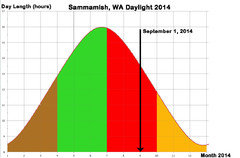
PC
theforgottenone1013 (SE MI zone 5b/6a)
9 years agolast modified: 9 years agoUnless I'm mistaken, the graph that you included, PC, actually goes along with what seysonn is theorizing. That decreasing day length does have an effect on when pods set. It hasn't been just this year that seysonn has theorized this either as I remember reading about it before now (just searched for it and it's the fourth post down in the link below). Seems the same exact thing happened last year as this year.
Now whether or not seysonn's plants were pollinated by other plants I obviously cannot say. Whether a brief upswing in the nighttime temperature played a role I cannot say.
Rodney
Here is a link that might be useful: Tomatillos tons of flowers... No fruit?
This post was edited by theforgottenone1013 on Mon, Sep 15, 14 at 22:02
PupillaCharites
9 years agolast modified: 9 years agoRodney, you are not mistaken, I put the information out there in a form we can quantify what he is claiming, to be fair.
IMO seysonn's confused correlation with causation. There is no reason to suspect that 14-15 hours vs. 13 hours of light will do anything except help boost the plants with more light they need.
He asserts that the northern part of Washington State is a reasonable comparison to Mexico regarding day length ... which is quite absurd IMO, when you consider the total Solar power during Mexican Summers is overpowering anything the Washington/Canadian border area can deliver.
There is no theory, since he has done nothing to control the factors already known as important, namely checking when other pollen sources become available and how his Mexican Husk Tomato handles cold temperatures so far from home and what effect that will have on fruit setting, or even getting the accumulated solar watts and intensity.
Reminds me of when he complains about hybrids being readily breed-able and other mavericky such things. But the subject is an interesting excuse to see what sort of weather his section of the country faces in the further northern reaches of Husk Tomato growing.
Here, if you look at his April, May, June, and July you will see that until July temperatures at night regularly dropped to below 50 F, and July had a good run early on but then quickly lost steam and had cool night temperatures. It wasn't till mid August that he had a good warm night performance and pollen from other sources likely became plentiful and could reach his plant:
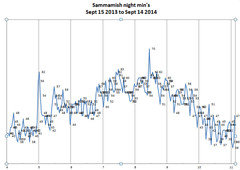
That IMO is more of a theory rather than anecdotal claim since it has been established that Tomatillos have a barrier to self-pollination. He’s had flowers all this time but no set. Cold nights and little pollen, no big surprise ... no set. Their threshold is somewhere between 50 F -55 F Warm nights, which in turn get all the tomatillos going wild and presto, fruits. Not complicated, and no need to say Washington has too long a photoperiod for Tomatillos in the summer!
PC, always interested in seeing tropical plants being grown in temperate climates.
seysonn
Original Author9 years agolast modified: 9 years agoThanks PC and Rodney.
The source of other possible cross pollinator plant( as put forward) is also mythical. The area where I am is not a prairie. It is mostly new modern residential developments, well manicured landscapings, practically with no unattended open area. The rest of raw land is wooded with western evergreens.
I asked how come it (cross pollination) did not happen in June, July and August but in September ? PC is saying that warmer nights set the stage for husk setting. I must inform you that all of June, July, August our night temps have been average around 56-57F. I check it more than once a day. All summer I
there has been no more than 15 nights with lows staying over 60F and higher as it follows per Accuweather data bank:JUNE 0 nights. highest low 58 , only twice
JULY 5 nights
AUGUST 12 nights (90 % from 1st to 19th)
SEPT (so far) =0 . The highest of lows has been 59FLook at this, if you will: Today's high was 89F. Tonight low will be 53F.
As Rodney already mentioned, the day length (shown in PC's graph) Is exactly what I have theorized.PC wrote:
In middle August and late August you had your two spurts of warm night time temperatures, so you now have the results of them in September,
not true , PC. According to the data, per accuweather in front of me (another page).here are the numbers:
MID to END of August night low occurances : 60F>5 times;;; 59F> 2 ;; 58F> 2 ;; 57-53F> 7 times.
60F is not a "WARM" night by any stretch of imagination.seysonn
Original Author9 years agolast modified: 9 years agoPC wrote:
He asserts that the northern part of Washington State is a reasonable comparison to Mexico regarding day length ... which is quite absurd IMO, when you consider the total Solar power during Mexican Summers is overpowering anything the Washington/Canadian border area can deliver.
................................
absolutely wrong. Where did you get that from?
I have been saying to the contrary all along that Mexico has shorter summer days ( 12 to 13 hrs, just rough estimate) and I made a theory that perhaps tomatillo (Like some other plants) is day length sensitive..Second: How did you construct your last chart?
here is Sep 1rst to 15th lows (Actual)
55/ 57 /55/ 52/ 57/ 59/ 56/ 56/ 56/ 54/ 55/ 50/ 53/ 54F
Aug. 20 -31
57F/ 52/ 56/ 57/ 56/ 58/ 60/ 61/58/ 59/ 59/ 57so actually there has been no shift in night lows all of August. The average has been steady at around 58F.
If you really put together a temperature comparison
PupillaCharites
9 years agolast modified: 9 years agoOK, I don't want to make a scandal by picking the wrong overnight lows, so let's just stick with yours since those are the ones you feel are representative. Here's what I found at accuweather low temperature date from June to Sept 15 in Sammamish with the colors added to look through my glasses:

With respect to the photoperiod, I pretty much dismissed that it had anything to do with it since you said they'd been flowering. If day or night length had anything to do with it there wouldn't be any blooms initiated in the first place IMO. An argument against that would be to name any reasonable Solanaceous plant that is sensitive to long day (rather than short, which seem to be more likely IMO).
As for the Husk Tomato genus weeds, I'd love t go visit the Olympic Rainforest sometime and stop by on the way to spend a day poking around the neighborhood to find stray tomatillos and crosses of them. Loser has to buy the beers LOL. Lots of parks around there, and where did you buy your plant, at the Home Depot down the road in Issaquah,or, Redmond or Bellevue, or some nearby Lowes or Walmart, my point being there are other plants getting out there, and places where husk tomatoes can escape and grow near the Friendliest City in America ;-)
PC
PupillaCharites
9 years agolast modified: 9 years agoI meant to add that while I did the low temp picture above from accuweather, I couldn't help noticing that the highs also became abruptly tamed in mid-August, also correlating with your results, and could also contribute to having a more comfortable Mex Husk Tomato plant;
In any case that's another factor to consider if you want to get to the bottom of what allows the plant want to set fruit without jumping to any conclusions and eliminating other ideas that are more likely from what we know about tomates. That would probably as big a priority to check out as cool nights. Basically the same two factors that cause my tomatoes here in pseudo-Florida (Northern Coast) not to set, hot nights in the summer and cold nights in the winter, even when you can mitigate them to get the plants through they don't always set, and then the temperatures change and the fruit sets like clockwork.
PC
seysonn
Original Author9 years agolast modified: 9 years agoPC,
Your juggling the numbers does not prove the requirement for having more than one plant.
I had already done reporting the appropriate lows from Accuweather . And that proved nothing in support of your point.
I have not entered weather into this discussion. Because our weather has been quite steady. BUT if any effect coming from the weather HAS NOTHING TO DO WITH THAT YOU MUST HAVE MORE THAN ONE PLANT. that has been my point. The day length theory, is just that a theory that offers some possible explanation.
It has been said that tomatillo is native to Central Mexico ( latitude about 25N). Sammamish WA is on/near latitude ~48N.
I have done this experiment in Atlanta, GA (latitude ~33N) and got early and better results down there (Twice).As far as blooming and not setting: As I mentioned before , the plant already had few flower on it when I bought it from nursery and kept flowering all along. Flowering and setting fruit are different issues. It happens in a lot of plants. It is called Blossom Drop. That is when the conditions are not right(Whatever they might be).
This is a FACT that my plant kept flowering June, July , August , September. And only from very late August and early September it started growing and ballooning husks.Cross pollination theory is not correct. Even presence of insects is not a requirement tho it can be helpful. Last year my plant was sprawling. An when I pulled it after the frost, it had many husk touching the ground that I don't thing bees would bother that much. Anyway, that is beyond the point.
Enough said already.
PupillaCharites
9 years agolast modified: 9 years agoLet's see. Your OP with all the shouting and myth busting made two extraordinary claims.
1) You had no fruit set through August although you had lots of blooms the whole time.
2) Suddenly in September they went gangbusters self-pollinating.You made the "theory" to fit your data, that although they self-pollinate fine, the day length was too long for them to set fruit, but as soon as the day length in Washington became 13 hours, all was fine and they self-fertilized and set fruit vigorously.
Problem with this sort of thinking is, there are already theories out there that explain everything that happened better than anything you said. Simply, the nights were too cold and the days were too warm, so the 13 hours day becomes a total red herring that didn’t belong in your post to start with since you confused a correlation with causation. Now you complain to me for opening my mouth about the absurd length theory to explain what already has IMO a very solid explanation. Hey, I wouldn’t be talking about it if it wasn’t part of your interpretation of your experience and discussed at length in your post.
Then we are back to the self-pollinating “myth” you aretrying to set straight, which is the first part of the two extraordinary claims. Extraordinary because nearly every reference for people that grow these plants mention the genetic barrier and it is out there in the literature by people who studied it. I say it is more likely someone else is growing tomatillos (and they do seed very well on their own) after reading your comment that the bees are all over the plant. You don't accept that.
I agree to disagree ;-)
Isolate a plant if you want to make an extraordinary claim on self-pollination, even though when you got your plants the day length was similar and no fruits were formed.
Perhaps you are always getting mutant plants. Hey, at least you don’t sound so keen on the day-length business now that I made you look at the highs and lows and you apparently came to the conclusion by yourself that highs abd lows are the most likely explanation for failure to set fruit, just like tomatoes LOL. Seemed to me you were so sure of your self-pollinating theory, that you invented the day length theory to explain why it didn't initially self-pollinate with all the blooms that fell off since you were focused on self-pollination and not thinking it through. Now you get my point that the blossom drop is temperature related. No problem. Thanks for the spirited discussion. It is good to challenge the status quo and I respect that.
PC
This post was edited by PupillaCharites on Tue, Sep 16, 14 at 18:53
digdirt2
9 years agolast modified: 9 years agoSo all this ranting is just so you can claim that you are right and everyone else is wrong? How profound! Since when does 1 incidence of anecdotal experience prove anything?
The recommendation is to plant more than one for several reasons. No different than planting 1 artichoke, 1 stalk of corn, 1 squash plant, etc.
Hey, if you only want to plant one tomatillo plant - go for it. But shouting from the mountain tops that you have solved one of the great mysteries of life is just plain silly..
Dave
seysonn
Original Author9 years agolast modified: 9 years agoPosted by digdirt 6b-7a North AR (My Page) on
Tue, Sep 16, 14 at 19:22So all this ranting is just so you can claim that you are right and everyone else is wrong? How profound! Since when does 1 incidence of anecdotal experience prove anything?
%%%%%%%%%%%%%%%%%%%%%%%%%%%1 incidence of anecdotal experience prove anything?
It is not JUST ONE incidence. And it is not anectodal. You are free to think so. It has been done 4 times. Even a single incidence prove that you can have tomatillo fruits with just one plant. But I have done it 4 different time, in GA and WA.
You have to come up with a reasoning not just saying "everybody else says this or that"BTW: You have said the following before:
" Posted by digdirt 6 -7 AR (My Page) on
Mon, Jul 25, 11 at 21:32Just like tomatoes, they will only set fruit within a specific air temperature and humidity level range. That is regardless of how many plants you have.
So while I agree that you get the best results with more than one plant, IF the pollen is viable it is possible to get a few fruit from a single plant. "
HMMM. What is "few"?This post was edited by seysonn on Tue, Sep 16, 14 at 21:57
seysonn
Original Author9 years agolast modified: 9 years agoHere are some others who have said. So It is not anectodal
Posted by wertach 7b SC (My Page) on
Tue, Jun 3, 14 at 12:39I agree seysonn, I have grown one plant many times also and they produced.
My reason for only having one plant sometimes is because I don't use many tomatillo's and one plant is more than enough.
----------------------------
Posted by fmart322 Z6SNJ (My Page) on
Tue, Jun 3, 14 at 20:35I've grown just one plant and it produced a lot of fruit.
it also got huge and took up a lot of space.
---------------------------------------carolyn137
9 years agolast modified: 9 years agoSummary?
Sometimes a person will set out one plant and get fruits and have no idea if there are any other Physalis species nearby that could overcome the incompatibility of that one plant.
Some persons think that Tomatillos have the same temperature requirements to set fruits as do tomatoes, and some don't/
Some think this thread has run its course and some don't, I'm in the former group.
Carolyn, who has grown tomatillos and Cape Gooseberries and Chinese Lanterns in the Physalis genus.
Carolyn
Here is a link that might be useful: Physalis Genus
missingtheobvious
9 years agolast modified: 9 years agoTomatillo is self-incompatible, so all plants are hybrids.
WHAT? It is self-incompatible, so they are hybrid?
Does that imply that, e.g, a hybrid tomato is self-incompatibleThere are different kinds of botanical incompatibility.
Self-incompatibility means that the plant in question must be pollinated by a different plant. So your tomatillo plant cannot pollinate itself, but your plant can be pollinated by another tomatillo plant of the same variety, or by another tomatillo plant of a different variety. [I've never heard before that tomatillos can be pollinated by other Solanaceae, so I can't address that issue.]
All tomatillos are hybrids in the sense that the pollen parent is a different physical plant from the plant which bears the fruit.
Here's a PubMed abstract dealing with how self-incompatibility works:
Self-incompatibility is a widespread mechanism in flowering plants that prevents inbreeding and promotes outcrossing. The self-incompatibility response is genetically controlled by one or more multi-allelic loci, and relies on a series of complex cellular interactions between the self-incompatible pollen and pistil. Although self-incompatibility functions ultimately to prevent self-fertilization, flowering plants have evolved several unique mechanisms for rejecting the self-incompatible pollen. The self-incompatibility system in the Solanaceae makes use of a multi-allelic RNase in the pistil to block incompatible pollen tube growth. In contrast, the Papaveraceae system appears to have complex cellular responses such as calcium fluxes, actin rearrangements, and programmed cell death occurring in the incompatible pollen tube. Finally, the Brassicaceae system has a receptor kinase signalling pathway activated in the pistil leading to pollen rejection. This review highlights the recent advances made towards understanding the cellular mechanisms involved in these self-incompatibility systems and discusses the striking differences between these systems.
http://www.ncbi.nlm.nih.gov/pubmed/11814052
==========
The source of other possible cross pollinator plant( as put forward) is also mythical. The area where I am is not a prairie. It is mostly new modern residential developments, well manicured landscapings, practically with no unattended open area.
Well, whether or not there are any wild Solanaceae in the area, residential developments are just the place I'd expect to find a few veggie gardens with tomatillo plants!
Got yuppies in the neighborhood? Got Latinos? Got foodies? Got anyone who makes salsa? Then the chances are excellent that you're not the only tomatillo-grower. And as was said above, the bees are bringing the pollen to your plant.
==========
So since you have no way of proving that your tomatillo fruit haven't been fathered by half a dozen different tomatillos planted by your neighbors, the only way you can logically claim that tomatillos aren't self-incompatible is to grow a single plant in total isolation (completely closed and bee-less greenhouse, etc.), flick the flowers each day to encourage the pollen to move, and then see if you have any fruitset.
==========
Tomatillo is self-incompatible, so all plants are hybrids.
WHAT? It is self-incompatible, so they are hybrid?
Does that imply that, e.g, a hybrid tomato is self-incompatibleNo, it doesn't imply that a hybrid tomato is self-incompatible. Tomatillos are self-incompatible, but tomatoes aren't self-incompatible. Therefore, there is no reason to believe that a hybrid tomato would be self-incompatible.
Furthermore, the sense in which "hybrid" is being used is different for tomatoes and tomatillos. All tomatillos are by definition hybrids -- their genes come from two different plants. Tomatoes, on the other hand, need not have two different parents: pollen can fertilize the same plant (even the same flower). In that case, each seed contains two identical sets of chromosomes.
And if a tomato is fertilized by another tomato of the same OP variety, then each seed contains two sets of chromosomes with exactly the same genes. (Same deal.)
When I was in junior high I could have told you why your "then hybrid tomatoes are self-incompatible" argument is a logical fallacy, but that was half a century ago.... Maybe someone younger can address that.
seysonn
Original Author9 years agolast modified: 9 years agoSome think this thread has run its course and some don't, I'm in the former group.
Carolyn
5%%%%%%%%%%%%
with due respect, you don't have to participate. This is just a free for all topic.Some persons think that Tomatillos have the same temperature requirements to set fruits as do tomatoes, and some don't/
Are we talking about temperature requirement/conditions here ? NO!
Are we comparing tomatillo setting fruits to tomato ? NO.The point is: CAN A SINGLE TOMATILLO PLANT PRODUCE FRUITS ? This is regardless of temperature.
Let me propose a possible scenario here:
Suppose that I did one or more cuttings from my sole plant early on and ended up with 3 plants. Will then they produce fruit ?
I would think that the flower on all those plants are genetically identicalAnother scenario.
I saved seeds from a single tomatillo fruit. And subsequently planted, say, 3 seeds and each became a plant, growing next to each other. Would they then produce fruits ?I would think again that the flower on all those plants are genetically identical
carolyn137
9 years agolast modified: 9 years agoSome think this thread has run its course and some don't, I'm in the former group.
Carolyn
5%%%%%%%%%%%%
with due respect, you don't have to participate. This is just a free for all topic.&&&&&
No Seysonn, I don't have to participate in this thread or any other thread, but since I put up the link that I did a lot of posting has referred to information in that link.
So I will post where and when I want to.
Carolyn
seysonn
Original Author9 years agolast modified: 9 years agoSo I will post where and when I want to.
Carolyn
%%%%%%%%%%%%
sure, of course. That is the choice we all do have.
Thank you .seysonn
Original Author9 years agolast modified: 9 years agoAN IDEA:
I am going to isolate a few buds, which have not opened yet ( by nylon tulle). This way no insects can possibly have a chance to introduce pollens for another source. This will take some time. I should have thought about this earlier.
PupillaCharites
9 years agolast modified: 9 years ago"AN IDEA: "
That may be someone's idea, but it is an experiment.
You wrote:
"Another scenario.
I saved seeds from a single tomatillo fruit. And subsequently planted, say, 3 seeds and each became a plant, growing next to each other. Would they then produce fruits ?I would think again that the flower on all those plants are genetically identical"
No, no and no, for the three plants. Stop making assumptions and better inform yourself. Each seed is the product of a different pollen particle. Tomatoes and by extrapolation husk tomato, sex and conception is different from human sex, there are, for argument's sake, from 20 - 300 ovules in a blossom if I have that right. Your tomato is the product of an orgiastic union in which one pollen grain ends up satisfying one ovule and plenty of pollen grains can end up as odd men out. That is why complete pollination can be important if you want a big tomato, since partial fertilization may not stimulate unfertilized ovules to develop seeds *as well as* tomato flesh surrounding them.
Further easy experiments you can try, if you are willing to not presuppose your conclusion of self-fertilization, are:
(1) to count how many healthy looking seeds are in the fruit you already have set.
and (2) try to sprout them (10 days, typical) just like tomato seeds.
In experiment (1) you are checking the uniformity of pollination which is self-fertilized vigorously would probably reach a maximum level of the total number of ovules. If by introduced pollen from other sources, this might vary. Check a random distribution of fruit sizes so not to introduce systematic error.
In experiment (2), which you will finish in two weeks' time, you are checking an alternate hypothesis that is reasonable to check, and would post-facto, potentially support your conjecture of "self-fertilization" (actually not fertilization but simply self-stimulation).
If the seeds sprout, you now have data that your fruits contain viable seeds. If they do not sprout and you do a serious job at it, that would suggest that fertilization never took place, but pollination or some other mechanism did stimulate fleshy growth. This is an interesting hypothesis to me in that if it were found to be, likely further hypotheses would be pollen from the same plant may have triggered the fruit growth, but fertilization may have been prevented, sort of between the extremes being argued.
The birds and bees of Tomato Love, as PC understand it.
This post was edited by PupillaCharites on Wed, Sep 17, 14 at 12:12
Deeby
9 years agolast modified: 9 years agoI think you guys need to step outside and lace up the gloves. This is insane. It's freakin' tomatillos for crying out loud. Big whoop.
seysonn
Original Author9 years agolast modified: 9 years ago
IDEA, is idea for an experiment here. Is that understood ?
I don't like to get into lengthy discussions on details of genetics.
But you did not say anything about cloning ?
If I plant 3 clones, what will happen ?
--------------------
"In experiment (1) you are checking the uniformity of pollination which is self-fertilized vigorously would probably reach a maximum level of the total number of ovules. If by introduced pollen from other sources, this might vary. Check a random distribution of fruit sizes so not to introduce systematic error.In experiment (2), which you will finish in two weeks' time, you are checking an alternate hypothesis that is reasonable to check, and would post-facto, potentially support your conjecture of "self-fertilization" (actually not fertilization but simply self-stimulation). "
------------------------------------------I am not interested in doing such experiments.
Just answer the cloning question (if you will) AND also what would be your explanation if an isolated bud/ flower produces fruit ? If it happens ?
seysonn
Original Author9 years agolast modified: 9 years agoPosted by Deeby 9b (My Page) on
Wed, Sep 17, 14 at 14:10I think you guys need to step outside and lace up the gloves. This is insane. It's freakin' tomatillos for crying out loud. Big whoop.
%%%%%%%%%%%%Don't you worry, Deeby !
Nobody is getting hurt here.PupillaCharites
9 years agolast modified: 9 years ago"I don't like to get into lengthy discussions on details of genetics. I am not interested in doing such experiments.
Just answer the..."
All right seysonn,
No further need for responses to anything here LOL, since disinterest is contagious, and it is evolving to be off topic...not transferrable to tomatoes. I see you already made your conclusions and would much rather mark fire hydrants than a constructive and enjoyable discussion about "genetics" which is what I want.
Please accept my wishes for good luck with your project, and any respectable original idea you may have. If you should learn anything new either way, there is nothing wrong with adjusting your ideas as part of the reasearch and learning curve. I do it all the time.
(Deeby, I actually agree with seysonn. No one is getting hurt, just bored, impatient, irrational, stir crazy and whatever else is typical when herding cats)
PC, who believes men sent by NASA walked on the moon.
aphidsquish
9 years agolast modified: 9 years ago"I see you already made your conclusions and would much rather mark fire hydrants than a constructive and enjoyable discussion about "genetics" which is what I want."
Seemed to be the whole point of the thread to begin with.
seysonn
Original Author9 years agolast modified: 9 years agoroper2008
9 years agolast modified: 9 years agoI grew 2 tomatillo plants. Mine produced through the heat of the summer. I
harvested mine in August.John A
9 years agolast modified: 9 years agoMine look like those in Seysonn's photo (except the tops are chewed off). Do I have to wait for the husks to open before I harvest?
John Aroper2008
9 years agolast modified: 9 years agoMy tomatillos filled the husk completely, opening the husk
by themselves. No empty space. If yours are not open, they
are probably not ready. This is the first time I have grown them.
I would pick them before a freeze though and try
them out.seysonn
Original Author9 years agolast modified: 9 years agoTime For A Little Update:
On Sept 17, I wrote "
IDEA, is idea for an experiment here. Is that understood ?
I don't like to get into lengthy discussions on details of genetics.
But you did not say anything about cloning ?
If I plant 3 clones, what will happen ?Subsequently I isolated two bud, not nearly to open yet. I covered them with tight nylon tulle, that no even smallest insect
So then I gave them time to flower and finish all sexual activity. Finally I saw husks formed in the tulle.
Removed the tulle and marked them ( by tying a piece of the same tulle:
I Think, probably this late in the season that temps are going down to 50s and 60s those husks won't be filled but nevertheless the flowers have been self pollinated and fruits formed.
So this experiment has proved 100% to me that tomatillo is in fact both self pollinating and self sufficient, just like tomatoes. I am sure that inter pollination within a SINGLE plant by wind or insect can improve the odds.
CASE CLOSED !
seysonn
Original Author9 years agolast modified: 9 years agoHARVEST
With the frost in forecast, yesterday I harvested some husks near full. But since my plant started setting much late in the season and due to cool temperatures afterwards, the husk did not get real full. Amazing thing is that I found some flowers on the plant. The plant still looks healthy while all my my tomatoes are dead and gone.
Here is a picture of my harvest. Ten times more are left on the plant which are half full or even smaller
PupillaCharites
8 years agolast modified: 8 years ago"So this experiment has proved 100% to me that tomatillo is in fact
both self pollinating and self sufficient, just like tomatoes. I am sure
that inter pollination within a SINGLE plant by wind or insect can
improve the odds. CASE CLOSED !"Remember this thread LOL!!!
I wonder if you got developed seeds from these fruits, saved them and did a % germination test to give any ideas; to see about sterility, and best yet, if fertile, grew any out?
I hope you checked that since the question has become relevant to me this season (to be fair I revived this old thread). Did you do the test? Get viable seeds? Grow any out?
Cheers
PC
Seysonn_ 8a-NC/HZ-7
8 years agoI wonder if you got developed seeds from these fruits, saved them and
did a % germination test to give any ideas; to see about sterility, and
best yet, if fertile, grew any out?^^^^^^^^^^^^^^^^^^^^^^^^^^^^^^
PC, As you see in my last post dated Nov. 11, 2014, the harvested tomatillos were NOT matured and thus no seeds to be saved. They made the best pickle though.hehe
SeyPumpkin (zone 10A)
8 years agoI solved the daylight debate for you guys. Both my parents and I grew tomatillos this year. We're at the same latitude just different temperature zones. Day length is the same. We're all competent gardeners. I had three plants, the set some fruit in May and promptly died of heatstroke. My dad's (in a cooler climate, say 10-15 degrees cooler thanks to the ocean but same latitude) didn't set until June and are going strong. Lesson--like peppers, tomatillos need a particular temperature range to set, nothing to do with day length.
It would be hilarious if the one lady above found out that her neighbor also had tomatillo plants that she didn't know about. People grow all kinds of things behind their fences.PupillaCharites
8 years agolast modified: 8 years ago"As you see in my last post dated Nov. 11, 2014, the harvested tomatillos
were NOT matured and thus no seeds to be saved. They made the best
pickle though."OK, immature pickled tomatillos sound pretty fun!
If you looked hard enough did you see any immature seeds, even now in the pickles, which looked 'normally' developing although they weren't ready? I've got a plant under very different conditions that has completely failed to set fruit after many flowerings, and guess what, now that it is 8 feet tall? Suddenly, berries on all the growing tip's flowers. If anything heat would be to blame here for the lack of flowering, that hasn't let up, but the humidity during the fruiting period had been absolutely the most awful and should have made it even harder. I'm thinking the fruits are going to be infertile, so I need to go find some pollen if I want seeds.
I have a different speculation on your key comment:
"With the frost in forecast, yesterday I harvested some husks near full.
But since my plant started setting much late in the season and due to
cool temperatures afterwards, the husk did not get real full. "I'm thinking there were few or no "mature" ones to be found since there might have been a lack of seeds, rather than the cold or the late start - you mentioned some were pretty filled out. I buy tomatillos regularly in the grocery store and they are always full with the husk glued to the bloated round fruit. I have never noticed a tomatillo that wasn't near perfectly round in the husk, and many I put in the bag are small fruits, deep dark green with noticeable smaller seeds. None have the mis-shapen quality in some of yours in the harvest pic, and I never remember finding one that isn't filling out the husk ... Could it owe that to lack of fertility (seed?) in your opinion?
I'd really like to save myself the work of hunting down some pollen for my plant and basically turning it into a breeding project at the last minute, since there is so much more I have to worry about getting done now like trashing a motley crew of plants outside that consume tons and mostly need to be pulled, bagged and trashed. But I need to harvest self or crossed seeds from this particular plant or I'll run out of seed.
Cheers
PC
PupillaCharites
8 years agolast modified: 8 years agoThanks Marianne, these are definitely interesting little "tomatoes" :-). I see you had three plants but anyway if you have any comments on what I'm asking Sey, for our case of a single plant, please give me a little help in that department if you could.
For example, did your immature tomatillos always have the husk clinging on them and were they always round, or did some start differently and then fill it out, and if harvested immature like Sey's pic what did the developing seeds look like if you happened to notice... were they fairly large?
Cheers
PC
antmary_Omaha_NE_5b
8 years agoThis is my first year of growing tomatillos, so I have no experience with it. I was surprised how fast they were growing in the cold spring and how early they started to flower, comparing to real tomatoes, which apparently did not like cold weather. The first husks with fruit appeared at the end of May. Interestingly, that at first only one plant set fruits, then after a week or so the other one started to set fruits. They had very different types of husks, so it was easy to distinguish between them. Finally, the last plant also had fruits. Although they were sowed at the same time and flowered at the same time and they were of the same size, they had different ability to set fruits. Anyway I have many ripe tomatillos now and there will be a lot more until the end of September. I am really surprised that Sey's tomatillos began to set fruits only in September.
Seysonn_ 8a-NC/HZ-7
8 years agoIn my case flowering was not a problem. Ever since I bough the plant from nursery it had flowers and kept on flowering all along.
Like I have said it set fruits much too late. When I picked some bigger ones they were still to small compared to What you find in store that the husk gets so full that it bursts open and the husk starts drying out.
ABOUT SEEDS:
PC,
I have a few still in the pickle. I took some out and cut them. I found 2 tiny tiny seeds in one of them.
Sey.
caryltoo Z7/SE PA
8 years agoAntmary, my tomatillos set fruit in May, too, and were wintersowed as well. They are not fragile, hothouse-type plants. In fact, I planted my two out then noticed I have volunteers all around the garden, presumably from the many I just tossed due to earwig damage last year. They are like huge weeds and the ones I didn't pull have set fruit, too. I think I'll be setting a table out front offering the fruit for free. Since we have a fairly large Latino population, with many working on lawn crews in the area, I'll hope they get taken and used. The few ripe ones I've gotten so far look way better than what I've seen in the grocery store. :)
antmary_Omaha_NE_5b
8 years agoYes they grow like weeds without care and spraying, and produce easily. My tomatillos are supposed to be purple, but I do not see any shade of purple on them. When they ripe, they just get yellowish color. I add tomatillos in tomato salsa, when I can. They make salsa chunky. I which there will be tomatillos with more interesting flavor.
John A
8 years agoI also have about a dozen volunteers in addition to the six I started inside in early April. Mine started setting fruit in early July. My experience last year was that they are smaller than the ones in the super markets. I also have some of the purple ones. The plants have a slight purple shade on the leaves, but the fruit look the same as the green ones.
John A
Pumpkin (zone 10A)
8 years agoI've heard that if you grow purple ones near a green one, they turn green. Dunno why!
Mine were always roundish and they weren't ripe until they split the husk. The seeds looked normal. Mine were volunteers from compost ( I put 1 fruit in the bin and somehow got about 6 total volunteers!). Mine were ok, just my summers were too extreme for it, even in the shade. Now that I think about it, one even set fruit in Oct/Nov last fall. They seemed to like the same temp range that peppers set in but can't tolerate as extreme highs.
Tomatillos are are basically open pollinated weeds as are a number of similar nightshade plants. Just because you have only one and see it being fertilized doesn't mean much. There's probably a related weed nearby that you don't know about that the bees have found. I know where I live, nightshade weeds are common. Garden huckleberries randomly volunteer in my yard even though I've never planted one.Seysonn_ 8a-NC/HZ-7
8 years agoI've heard that if you grow purple ones near a green one, they turn green. Dunno why!
^^^^^^^^^^^^^^^^^^^^^^
Most probably not true. The only way the two may influence each other is by cross pollination and that will show in the fruits of next generation.
Mine were not round , I think because they were still growing. .
Sey
PupillaCharites
8 years agolast modified: 8 years ago"I took some out and cut them. I found 2 tiny tiny seeds in one of them."
Sey, That is a very helpful observation and I appreciate your taking the time to do this grow out, look at the pickles and sharing what you saw, and of course your determination and enthusiasm for the project. I plan on discussing the situation with a husk tomato breeder when I can but I've spent a day really brushing up on these. A few comments:
- My own question's answer: The husk does fill out to some degree.
- Your comment they were immature/not filled out, except for a some you managed to get in time: Although you took a loss in yield for this, all of those tomatillos are still immature, even those filling out and forest green at the store, some more than others. All those stages, even when still small, are just fine to harvest and eat in salsas as is the typical use, just you lose some mass/yield. By the time they are kelly green or lime green they are considered no good (too sweet for salsa :-). Pickled tomatillos are not eaten, or if so they are uncommon in most of Mexico, so maybe you've pioneered a one of the latest West Coast new age cuisines and that's very cool :-). They are commercially available canned in Mexico, but just using citric acid usually for microorganism control ... adjusts product pH, like doing tomatoes. Tomatillos are sometimes grilled and I hear those are really good. I've only eaten fresh ones (blanched/lightly boiled for salsa), though, my whole life. Need to get bolder LOL.
Cheers
PC
Seysonn_ 8a-NC/HZ-7
8 years agoThanks PC
Yeah, definitely the ones I picked (the larger ones I could find) were immature You can see in the picture that were real green. and very few were just about to touch their husk.. Real mature ones will burst the husk open. I have had real nice ones back in Atlanta, GA years ago.
Well , at least I made some pickles along with the green tomatoes at the end of season..
Sey
PS: I made refrigerated style pickle, using some vinegar to acidify. Sure you can use citric acid as well. I also do fermenting style just with salt, no vinegar. The old fashion way (lacto fermenting).
antmary_Omaha_NE_5b
8 years agoI washed the ingredients for green salsa and I thought that I'll make a picture of them.
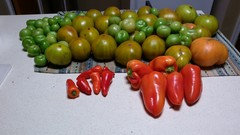
Tomatillos, green tomatoes (Malachite Box), sweet peppers (Antohi Romanian on the right and Sweet pickle on the left). Tomatillos are quite good when mixed with tomatoes.
antmary_Omaha_NE_5b
8 years agoThanks, Sey. The tomatoes are green-when-ripe Malachite Box. They'll make the salsa green and the taste will be better as if it's done only with tomatillos.


















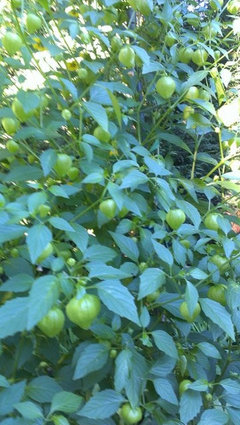

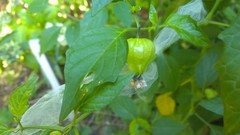

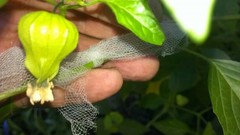


PupillaCharites